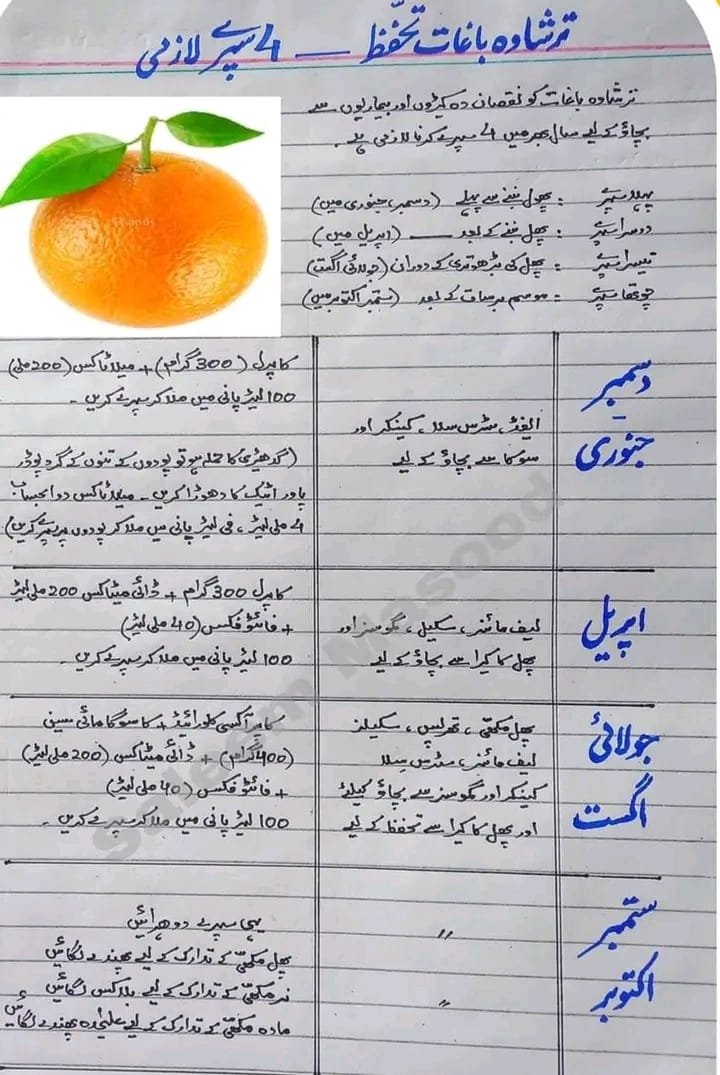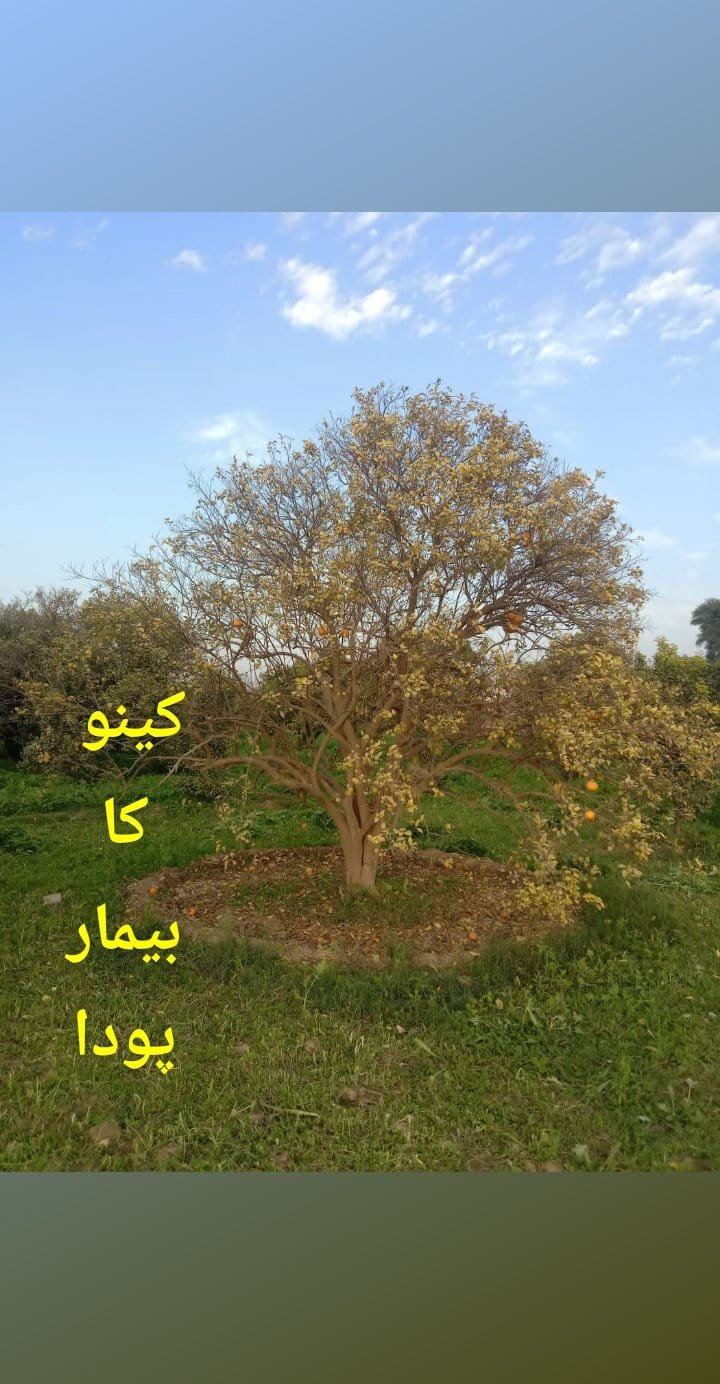
1. Gummosis/Bark Splitting
Symptoms
- Symptoms include rotted roots; cracked bark, accompanied by gumming.
- Water-soaked, reddish-brown to black bark at the soil line.
- Discolored tissue in the lower trunk. Yellowing, sparse foliage and death of the tree.
- Excess soil moisture favors production and spread of zoospores.
- Therefore, increased drainage and careful irrigation is an important factor in disease management.
Management
- Resistant Rootstock
- Cultural Control
Plant trees on high enough so that the first lateral roots are just covered with soil.
- Budding of the plants at height of 9 inches
- Chemical control
Copper 3 gm/lit. of water
Fosetyl Aluminium 2.5 gm/ lit. of water
Metalaxyl+Mancozeb 2.5gm/lit. of water
2. Citrus Scab
Symptoms
- Citrus scab attacks the fruit, leaves and twigs, producing slightly raised, irregular scab-by or wart-like outgrowths.
- The scabs are grey or pinkish at first and become darker with age.
- They are more common on lemon fruits than leaves.
- The raised lumps associated with scab can be confused with symptoms caused by the disease botrytis or with wind rub abrasions.
3. Citrus Melanose
Symptoms
Leaves
- Lesions begin as small, circular dark depressions with yellow margins.
- As the disease progresses, spots become raised and turn dark brown.
- Leaves turn yellow and prematurely drop.
Fruit
- Spots initially are small, light brown, and sunken.
- As the disease progresses, spots become dark and raised.
- Spots that are close together can coalesce to form a rough-irregular or rough surface.
- Damage is typically superficial on fruit.
- Lesions can typically be found on dying twigs.
It can be severe following rainy periods in the spring and seems to be worse when preceded by a freeze.
Control/Management of Scab/Melanose Diseases
- Cultural practices, Sanitation – pruning – No intercropping & careful irrigation .
- 3 Sprays are Recommended to control the diseases.
- 1st SPRAY (Before Flowering) Copper Based Fungicides e.g. Copper Oxychloride or Copper Hydrooxide @ 3gm/lit. of water
- 2nd SPRAY (After Petal Fall) Difenoconazole + Azoxystrobin ( Amistar or Nanok @ 1ml/lit. of water)
- 3rd SPRAY (Moon Soon) Copper Based Fungicides Copper Oxychloride or Copper Hydroxide @ 3gm/lit. of water
4. Citrus Canker
Symptoms
- Young lesions are raised on both leaf surfaces, particularly on the lower leaf surface.
- The pustules later become corky and crater-like, with raised margins, sunken centers and surrounded by a yellow halo.
- Fruit lesions vary in size because the rind is susceptible for a longer period of time and more than one infection cycle can occur on fruit.
- Twigs and stem infections resemble those on fruit.
- The lesions are raised with a corky appearance and can support long term survival of the bacterium.
- Major citrus canker outbreaks generally occur when new shoots are emerging or when fruit are in the early stages of development.
- Citrus canker is mostly a cosmetic disease, but when conditions are highly favorable for infection, it causes defoliation, shoot die-back, and fruit drop.
Disease Management
Exclusion
The first line of defense against citrus canker is exclusion.
Sanitation
Numerous cases of new infections of citrus canker are linked to human and mechanical transmission.
Eradication
Once introduced into an area, elimination of inoculum by removal and destruction of infected and exposed trees is the most accepted form of eradication.
Chemical Control
- 1st spray of Bordeauxe mixture (1%) after fruit harvest)
- 2nd spray during the month of April Copper Oxychloride @3gm/lit. of water)
- 3rd spray during the month of July-August Copper Hydroxide @2.5gm/lit. of water
5. Citrus Greening
Symptoms
- Stylar end greening
- Stylar end greening on samples of various fruit infected with HLB. The infected fruit is contrasted against non-infected normal fruit. (Note the greening at the stylarend in contrast to the normal orange color).
- Leaf mottle typical for greening disease
- leaf mottle and general chlorosis of leaves.
- Seed abortion
- Classical seed abortion from fruit of an HLB infected sweet orange tree. Note the small purple colored seeds contrasted with normal seeds. This is also typical for stubborn disease.
Management
- Removal of infected trees
- Vector control ( citrus psylla) by spraying Novastar or Confidar @1ml/lit. of water
- Disease free planting material
6. Citrus Psylla
Integrated Control Measures
- Following practices should be used to reduce the damage by citrus psylla:
- Monitor the population of citrus psylla by hanging yellow sticky cards on trees to capture adults.
- Prune the trees after the last harvest fruits.
- In biological control lady bird beetle and Temarixia radiata should be used as bio-control agents.
- Chemical control by chlorpyrifos , cypermethrin , imidacloprid , and Bifenthrin can reduce the population upto 70-80%.
7. Citrus Mealybug
Integrated Control of Citrus Mealybug
- Remove alternate host plants.
- Mealybugs are primarily managed by destroying their eggs by cultural practices
- Native predators include lady beetles, lacewings, and syrphid flies.
- Application of Carbofuran early in December with irrigation water kills the emerging nymphs/crawlers.
- Spray of Bifenthrin, imidacloprid, Acetamiprid @ 1.25 ml/liter of water or Methidathion @ 2 ml/ liter of water on the soil or on the trunk of the tree should be applied later.
8. Citrus Whitefly
Integrated Management of Citrus Whitefly
- Several parasites and predators attack the citrus whitefly. Lacewing larva (Chrysoperla sp.) feeds on whitefly nymphs and a wasp Encarsia is useful parasitoid of citrus whitefly.
- Yellow sticky traps are helpful for monitoring and suppressing adult populations.
- Always inspect new plants for whiteflies and nymphs before introducing them in the greenhouse or garden
- Water sprays (syringing) may also be useful in dislodging adults. Watering can also reduce the hot, dry dusty conditions that favor whiteflies and inhibit their natural enemies.
- If populations are high, use a least-toxic, short-lived organic pesticide such as Acetamiprid to establish control.
9. Citrus Thrips
Integrated Management of Thrips
- Monitoring citrus for citrus thrips begins at the initiation of bloom, but becomes critical at petal fall (90% blossom drop) in late-March to early April.
- A number of natural enemies attack citrus thrips including predaceous mites, spiders, lacewings, minute pirate bugs, etc.
- Spinetoram, spinosad, or abamectin are recommended to avoid severe mortality of natural enemies.
10. Citrus Red Scale
Integrated Management of Scales
- Trees should be internally pruned and opened up so that the parasites can gain access to the scales.
- Insecticides such as Pyriproxyfen , Buprofezin , and Spirotetramat are quite safer to use.
11. Citrus Leafminer
Integrated Management of Leafminer
- Application of fertilizers in winter to promote flush growth in spring when the pest is either absent or relatively scarce.
- Pruning of late summer and autumn flush growth can also be used to limit and remove unsightly infestations on home garden trees.
- Three of the most effective wasps are Ageniaspis citricola and Cirrospilus quadristriatus and Semiolacher petiolatus.
- imidacloprid, thiamethoxam and spinosad are recommended for Leafminer control.
12. Fruit Fly Insect Control
Integrated Management of Fruit Flies
- Following integrated control measures should be adopted for the fruit flies:
- Eradication of alternate and non-essential host plants.
- The collection and destruction of fallen, damaged and overripe fruits is strongly recommended to reduce the resident population of fruit flies.
- Fruit should be picked off from the trees as it ripens; this stops the flies from laying eggs inside it, and prevents any larvae surviving.
- Monitoring of fruit fly population in the citrus orchards by installing sex pheromone traps of yellow and/or transparent colors is highly recommended in the early summer to late in the season. Five traps per acre should be installed. Methyl Eugenol traps are used for male fruit flies while for female traps baited with protein hydrolysate should be used. These traps are impregnated with insecticide spinosad.












